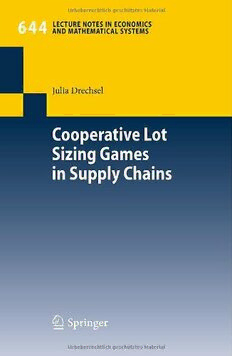Table Of ContentLecture Notes in Economics
and Mathematical Systems 644
FoundingEditors:
M.Beckmann
H.P.Künzi
ManagingEditors:
Prof.Dr.G.Fandel
FachbereichWirtschaftswissenschaften
FernuniversitätHagen
Feithstr.140/AVZII,58084Hagen,Germany
Prof.Dr.W.Trockel
InstitutfürMathematischeWirtschaftsforschung(IMW)
UniversitätBielefeld
Universitätsstr.25,33615Bielefeld,Germany
EditorialBoard:
H. Dawid, D. Dimitrow, A. Gerber, C-J. Haake, C. Hofmann, T. Pfeiffer,
R. Slowi ń ski,W.H.M. Zijm
Forfurthervolumes:
http://www.springer.com/series/300
•
Julia Drechsel
Cooperative Lot Sizing
Games in Supply Chains
123
Julia Drechsel
Germany
[email protected]
Zugl.: Duisburg-Essen, Univ., Diss., 2009
ISSN 0075-8442
ISBN978-3-642-13724-2 e-ISBN978-3-642-13725-9
DOI10.1007/978-3-642-13725-9
Springer Heidelberg Dordrecht London New York
LibraryofCongressControlNumber: 2010934000
© Springer-Verlag Berlin Heidelberg 2010
This work is subject to copyright. All rights are reserved, whether the whole or part of the material is
concerned, specifically the rights of translation, reprinting, reuse of illustrations, recitation, b roadcasting,
reproduction on microfilm or in any other way, and storage in data banks. Duplication of this publication
or parts thereof is permitted only under the provisions of the German Copyright Law of September 9,
1965, in its current version, and permissions for use must always be obtained from Springer. Violat-
ions are liable for prosecution under the German Copyright Law.
The use of general descriptive names, registered names, trademarks, etc. in this publication does not
imply, even in the absence of a specific statement, that such names are exempt from the relevant
protective laws and regulations and therefore free for general use.
Cover design: WMXDesign GmbH, Heidelberg, Germany
Printed on acid-free paper
Springer is part of Springer Science+Business Media (www.springer.com)
Preface
ThisbookresultsfrommyworkasaresearchassistantattheUniversitiesofFreiberg
andDuisburg-Essen.Startingthisresearchwasverychallengingdueto the highly
mathematically coined literature regarding game theoretical topics. The literature
showsthatcooperativegametheoryiswellstudiedfromatheoreticalpointofview,
but that fields of application are fairly limited up to now. Hence, the following
researchquestionarose:Whatcanbedonetomakeconceptsfromcooperativegame
theorymoreapplicabletopracticalproblems?
The field of supply chain managementis predestined for many kinds of coop-
eration because companies will be more successful if they consider relationships
tosuppliers,customers,and/orcompetitors.Therefore,thisworkfocusesoncoop-
erationsin supply networks(horizontaland verticalcooperation)concerningjoint
orderingand/orjointproduction.
Problemsoforderingandproductionforsingledecisionmakersarewellstudied
in operations research and are used as a basis to develop cooperative models that
displaysituationsofcooperativedecisionmaking.Beingoneofthemostessential
problemsincooperations,theallocationofjointprofitsorcostsisthefundamental
questionincooperativegametheoryandwillbethebasicquestionansweredbythis
workaswell.
Inbothplacesofmydoctorialstudies,FreibergandDuisburg,Ihadvaluablesup-
portwithoutwhichthisworkwouldnothavebeenpossible.Firstofall,IthankAlf
Kimmsforprovidingmethechancetoworkonthistopic,hisguidance,challenging
discussions,andthepossibilitytocontinuemyworkinDuisburg.
I express my gratitude to Sarah Bretschneider, Demet Çetiner, Michaela Graf,
Klaus-Christian Maassen, and Michael Müller-Bungart for providing me such a
greatresearchandworkingatmosphereinFreibergandDuisburg–allofyouhelped
methroughstruggleswithresearch,programming,orteaching,aswellassometimes
non-work related things, which was always valuable and helpful and made these
fouryearsawonderfultime.Furthermore,IwouldliketothankAnnetteHoffmann
andNadineKrumpholzforwelcomingmeinDuisburg,StefanieKockerolsforpro-
vidingmehelpwiththeliteratureresearchandÇag˘das¸ÖzgürforaconstantLATEX
support.
IamdeeplyindebtedtoIngmarSchaaffforhislove,hispatience,andforkeep-
ingmegroundedwheneveritwasneeded.Finally,Ithankmyparents,Nicoleand
v
vi Preface
StephanDrechsel,formakingsomanythingspossible,fortheirsupport,andtheir
trust.
Duisburg JuliaDrechsel
May2010
Contents
1 Introduction.................................................................... 1
2 SelectedTopicsinCooperativeGameTheory.............................. 5
2.1 HistoryofGameTheory................................................. 5
2.2 BasicsinCooperativeGameTheory.................................... 8
2.2.1 ACooperativeGame........................................... 9
2.2.2 PropertiesofCooperativeGames ............................. 11
2.2.3 Variants and FundamentalApplications
oftheClassicalCooperativeGame............................ 13
2.2.4 Interval-ValuedGames......................................... 15
2.3 AllocatingCooperativeCosts ........................................... 17
2.3.1 MotivationandClassificationofAllocationMethods........ 17
2.3.2 PropertiesofCostAllocations................................. 18
2.3.3 Non-Game-TheoreticalCostAllocationMethods............ 20
2.3.4 TheCore........................................................ 22
2.3.5 AdditiveCoreVariants......................................... 26
2.3.6 MultiplicativeCoreVariants................................... 29
2.3.7 TheSubcoalition-PerfectCore ................................ 32
2.3.8 TheIntervalCore............................................... 36
2.3.9 TheShapleyValue ............................................. 37
2.3.10 Conclusions .................................................... 38
3 AlgorithmicGameTheory ................................................... 41
3.1 Literature................................................................. 42
3.2 ComputingCoreCostAllocations...................................... 43
3.3 TheoreticalBackground................................................. 45
3.4 IncludingFairnessCriteria .............................................. 46
3.5 ComputingCoreVariants................................................ 49
3.6 ComputingIntervalCoreElements..................................... 51
3.7 Conclusions.............................................................. 52
vii
viii Contents
4 CooperationinSupplyChains............................................... 55
4.1 HorizontalversusVerticalCooperation................................. 56
4.2 SupplyChainGamesintheLiterature.................................. 59
5 AnEconomicLotSizingGame .............................................. 63
5.1 CooperativeOrderingSituations........................................ 63
5.1.1 TheUnderlyingProblem....................................... 63
5.1.2 PropertiesoftheELSGame................................... 65
5.2 ComputingCoreCostAllocationsfortheELSGame ................. 65
5.2.1 TheRowGenerationProcedure............................... 66
5.2.2 ANumericalExample ......................................... 69
5.3 ComputationalStudyfortheELSGame ............................... 73
5.4 ExtensionsfortheELSGame........................................... 79
6 ALotSizingGamewithUncertainDemand............................... 81
6.1 TheUnderlyingProblem................................................ 81
6.2 SpecialPhenomenaofIntervalCores................................... 82
6.3 ANewDefinitionoftheIntervalCoreandItsComputation .......... 83
6.4 ComputationalStudyfortheIntervalELSGame...................... 85
7 A CapacitatedLotSizingGamewithTransshipments,
ScarceCapacities,andPlayer-DependentCostCoefficients.............. 87
7.1 CooperativeProductionSituations...................................... 87
7.1.1 TheUnderlyingProblem....................................... 87
7.1.2 TheCLSPGame ............................................... 89
7.1.3 PropertiesoftheCLSPGame ................................. 93
7.2 SolvingtheCooperativeCLSP.......................................... 94
7.2.1 ALagrangeanRelaxationBasedHeuristic ................... 94
7.2.2 AFix-and-OptimizeHeuristic................................. 98
7.3 ComputingCoreCostAllocationsfortheCLSPGame................101
7.3.1 TheRowGenerationProcedure...............................101
7.3.2 ComputingtheSubcoalition-PerfectCore....................104
7.3.3 ComputingtheMinmaxCore .................................106
7.4 ComputationalStudyfortheCLSPGame..............................106
7.4.1 ComputationalStudy:LagrangeanRelaxation
BasedHeuristic.................................................107
7.4.2 ComputationalStudy:Fix-and-OptimizeHeuristic ..........109
7.4.3 ComputationalStudy:Subcoalition-PerfectCore ............114
7.4.4 ComputationalStudy:MinmaxCore..........................115
7.5 ExtensionsfortheCLSPGame.........................................117
8 AMultilevelLotSizingGamewithRestrictedCooperation .............119
8.1 CooperativeSupplySituations..........................................119
8.1.1 TheUnderlyingProblem.......................................119
8.1.2 GameswithRestrictedCooperation...........................124
8.1.3 PropertiesoftheMLCLSPGame.............................129
Contents ix
8.2 ComputingCoreCostAllocationsfortheMLCLSPGame ...........129
8.2.1 TheRowGenerationProcedure...............................130
8.2.2 ANumericalExample .........................................133
8.2.3 ComputingCoreVariants......................................135
8.3 ComputationalStudyfortheMLCLSPGame .........................136
9 ConclusionsandFutureResearch...........................................141
A ComputationalStudyCLSPGame..........................................145
A.1 ComputationalStudy:LagrangeanRelaxationBasedHeuristic.......145
A.2 ComputationalStudy:Fix-and-OptimizeHeuristic....................149
B ComputationalStudyMLCLSPGame .....................................151
Bibliography........................................................................155

